AUCTORES
Globalize your Research
Research Article | DOI: https://doi.org/10.31579/2637-8914/264
1 Republic of Turkey Ministry of Agriculture and Forestry, Field Crops Central Research Institute, Ankara 06170, Turkey,
2 Ankara University, The Faculty of Veterinary Department of Biochemistry, Ankara 06110, Turkey.
*Corresponding Author: Derya Özalp Ünal, Ministry of Agriculture and Forestry Field Crops Central Research Institute, Quality and Technology Department/Plant Food Research Center, Ankara, Turkey. Email: derya.ozalpunal@tarimorman.gov.tr.
Citation: Derya Ozalp Unal, Tevhide Sel, (2024), Impact of Extraction Methods on the Anticancer Potential of Garlic: A Study of White and Black Garlic Extracts, J. Nutrition and Food Processing, 7(13); DOI:10.31579/2637-8914/264
Copyright: © 2024, Derya Ozalp Unal. This is an open access article distributed under the Creative Commons Attribution License, which permits unrestricted use, distribution, and reproduction in any medium, provided the original work is properly cited.
Received: 06 September 2024 | Accepted: 20 September 2024 | Published: 01 October 2024
Keywords: garlic; black garlic; cytotoxicity
Colorectal cancer is one of the most common cancers globally, characterized by epithelial transformation and dysregulation. Phytochemicals derived from garlic exhibit anticancer properties by affecting key pathways such as cell proliferation and apoptosis. This study investigates the effects of maceration and cold extraction methods on the bioactive components, antioxidant activities, and anticancer potentials of white and black garlic extracts.
Black garlic, produced through fermentation, has lower moisture and protein content than white garlic, which is attributed to the Maillard reaction. Black garlic, particularly when extracted using the maceration method, shows higher total phenolic and flavonoid content, indicating increased antioxidant activity. In anticancer assays, black garlic extracts, especially those obtained by cold extraction, demonstrate significant cytotoxic effects on Caco-2 cells compared to white garlic extracts. The maceration method provides higher phenolic content but shows variable effects on cell viability, while cold extraction is more effective for black garlic.
These findings highlight how extraction methods affect the bioactivity of garlic extracts and underscore the potential of black garlic extracts in cancer prevention and therapy. Optimizing garlic fermentation and extraction processes could enhance health benefits, and future research should aim to improve these processes.
Colorectal cancer, including colon and rectal cancers, ranks third after breast and lung cancers, with a prevalence of 10% among cancer cases in the world in 2020. Colon cancer is multi-stage, characterized by complex and differentiated, irregular intestinal-epithelial differentiation, proliferation, and apoptosis [1, 2, 3]. According to the World Health Organization, 80% of the world's population uses traditional practices. Therefore, phytochemicals are being extensively researched [4]. As a result, phytochemicals have been reported to exhibit anticarcinogenic properties by influencing the onset and progression of cancer through the regulation of various pathways, including cell proliferation, differentiation, apoptosis, angiogenesis, invasion, migration, and metastasis [5, 6, 7]. Herbal remedies with anticancer effects are obtained from vegetables and fruits such as curcumin (turmeric), capsaicin (chili flakes), lycopene (tomatoes), resveratrol (grapes), sulforaphane (broccoli), and allicin (garlic) [8].
Garlic has gained a reputation in many cultures and folklore as a disease-protective therapeutic agent [9]. Raw garlic cloves contain about 65% water, 28
2.1 Chemicals and reagents
2,2-Diphenyl-1-picrylhydrazyl (DPPH•), AlCl3.6H2O, dimethyl sulfoxide, PBS, ethanol, gallic acid, gentamycin, Hydrogen peroxide, hydrochloric acid, lithium sulfate, MTT, methanol, sodium dodecyl sulfate, sodium hydroxide (NaOH), sodium molybdate dihydrate, sodium nitrite (NaNO2), sodium carbonate (Na2CO3), sodium tungstate dihydrate were purchased from Sigma-Aldrich Chemical Co. (St. et al., USA).
2.2 Plant materials and preparation of extracts
In the study, Taskopru garlic, which is unique to Kastamonu province and plays an important role in Turkey's garlic production, was used as a material. White and black garlic were obtained from the company of Umitköy Gurme (Kastamonu/Turkey). The white and black garlic were stored in a cool, dark room before use.
2.3 Cold extraction
The extraction method involved crushing white or black garlic into a paste, adding 20 grams of the paste to 100 ml of methanol, ethanol, or ultra-pure water, and then incubating the mixture in a water bath at 24°C for 2 hours. After centrifugation and filtration, the extracts were stored at +4°C. For cell culture, DMSO was added to methanol or ethanol extracts, while water extracts were mixed with DMEM, and all extracts were stored at +4°C until use [34].
2.4 Maceration
The extraction method by Güdücü (2014) was modified and used. Garlic was crushed into a paste and mixed with methanol, ethanol, or water. The mixture was kept in closed flasks, shaken in a water bath for 5 days, and then centrifuged. The solution was filtered, and extracts were stored at +4°C. Those for cell culture were evaporated and stored at +4°C until use [35].
2.5 Moisture content assay
The moisture content of white/black garlic is determined according to AACC's (2000) Method No. 934-01934-01. The 5 g sample was dried in a drying oven (Protech, model: T T107, N/A) at 105.5°C for 15 hours [36].
2.6 Crude protein assay
AACCI Method Nos determined the protein amounts of the white/black garlic. 46–30 using the nitrogen analyzer (Leco et al.) [37].
2.7 Crude fat assay
The crude fat content of the white/black garlic sample was estimated based on method no. 920-39 guidelines in AACC (2000). The amount of crude oil was determined in the soxhlet device (Gerhardt, Sox-416) using a dried sample (10 g) and n-hexane as the solvent [36].
2.8 Total ash assay
The ash content of white and black garlic was determined using the AACC Method No. 942-05 [38]. First, a 5 g sample was charred until no smoke came out. Next, the sample was burned in a mold oven at 550-600ºC (Mipro, model: MKF, 150601) for 5-6 h or until grayish-white residues were obtained.
2.9 pH assay
10 g of the garlic sample was blended in 100 ml of distilled water to measure pH. They were centrifuged for 3 minutes at 1500 rpm. The solution was filtered through filter paper. A pH meter (HANNA, model: HI 4221) measured the pH value of white and black garlic extracts [39].
2.10 Scavenging activity (DPPH•) assay
The extracts' free radical scavenging activities were determined using the 2, 2—Diphenyl-1-picrylhydrazyl (DPPH•) method [39]. The absorbance was measured at 515nm by the Shimadzu UV-1202 spectrophotometer.
2.11 Determination of total phenolic content (TPC) assay
The Folin-Ciocalteu method, as determined by Odabasoglu et al. (2004), was utilized to measure the total phenolic content of white and black garlic [40]. The samples were allowed to stand 90 min before measurement at 760 nm using the Shimadzu UV-1202 spectrophotometer. Finally, the total phenol content for white and black garlic was calculated in gallic acid equivalents (mg GAE/g). All the experiments were performed in triplicate.
2.12 Determination of total flavonoid content (TFC) assay
The total flavonoid content in white and black garlic was analyzed by a colorimetric method described by Boateng et al. (2008) [41]. The absorbance at 510 nm was efficiently recorded using the Shimadzu UV-1202 spectrophotometer. The samples were analyzed in three repetitions, and their results were presented as milligrams of rutin equivalent per gram (mg RE/g).
2.13 Cell culture
The Caco-2 cells, originally obtained from ATCC no. HTB-37, were cultured in T75 cm2 flasks in Dulbecco's modified Eagle medium (DMEM) with 4,500 mg/l glucose, 1% Penicillin-Streptomycin, 1% non-essential amino acids, and 10
3.1 Physicochemical properties of white/black garlic
In the study, the moisture content, crude protein, total fat, carbohydrate, and pH values of black garlic were all lower than those of white garlic (p<0>0.05).
| Components | Content in White Garlic | Content in Black Garlic |
| Moisture (%) | 69,33±0,96a | 37,94±0,02b |
| Crude Protein (%) | 11,16±0,91a | 6,93±0,03b |
| Crude Fat (%) | 1,94±0,02a | 0,71+0,02a |
| Total ash (%) | 2,51±0,02a | 2,02+0,01b |
| pH | 6,93±0,03a | 4,67+±0,02b |
*: mean±standard
**: The differences between the same lines are statistically highly significant (p<0>
Table 1. Comparison of contents of physicochemical components between white garlic and black garlic.
3.2 The antioxidant content of white/black garlic
Based on maceration and cold extraction methods, the total phenolic content of the aqueous black garlic extract using cold extraction was significantly higher than other groups (<0>0.05). The highest total flavonoid content was obtained in the aqueous black garlic extract of the maceration extraction (p<0>
11
| Total phenolic contents (mg GAE/g) | Total flavonoid contents (mg RE/g) | ||||
| Samples | Cold Extraction | Maceration | Cold Extraction | Maceration | ||
| BME | 0,88±0,07aABC | 2,40±0,12adE | 0,60±0,04aA | 3,00±0,11aB | ||
| BET | 0,66±0,14bAB | 1,58±0,13abCDE | 0,58±0,06aA | 2,21±0,27bC | ||
| BSU | 1,80±0,14cDE | 2,94±0,56deF | 0,26±0,03bD | 0,41±0,05cDEF | ||
| SME | 1,22±0,07dBCD | 3,43±0,26deF | 0,58±0,07aE | 0,81±0,05dAE | ||
| SET | 0,03±0,01eA | 0,67±0,10bAB | 0,30±0,02abF | 0,32±0,02cDF | ||
| SSU | 3,25±0,09fF | 3,72±0,71eF | 1,10±0,08bG | 1,89±0,03bH | ||
*: GAE = Gallic acid equivalents; RE = Rutin equivalents.
**: Values are mean ± SD.
***: a-d: Values followed by different letters in the row significantly differ by Duncan’s multiple range test (< 0>
****: A-H: Values followed by letters in the same line significantly differ by Duncan’s multiple range test (< 0>
Table 2. The total polyphenol contents of three different white and black garlic extracts were prepared using cold extraction and maceration methods.
3.3 Antioxidant activity of white/black garlic
The DPPH activity of aqueous black garlic was higher than other groups in cold extraction and maceration methods. The highest DPPH activity was obtained in the cold extraction of the aqueous extract of black garlic. In the maceration method, black garlic extracts showed higher DPPH activity than white garlic extracts.
| Samples | Cold Extraction | Maceration | |
| BME | 82,66±14,14aA | 53,07±5,10aBC | |
| BET | 50,83±7,23abB | 33,48±4,41bBD | |
| BSU | 79,89±13,89aC | 11,95±1,21cD | |
| SME | 1836,20±16,19cE | 2456±10,19dF | |
| SET | 34,28±2,11bBD | 40,52±3,84abBD | |
| SSU | 3194,40±15,85dG | 2388,80±3,92dH | |
*: GAE = Gallic acid equivalents
**: Values are mean ± SD.
***: a-d: Values followed by different letters in the row significantly differ by Duncan’s multiple range test (<0>
****: A-H: Values followed by letters in the same line significantly differ by Duncan’s multiple range test (<0>
Table 3. The DPPH activity of three different white and black garlic extracts was prepared with cold extraction and maceration methods (mg GAE/g).
3.3 Cytotoxic effect of white/black garlic
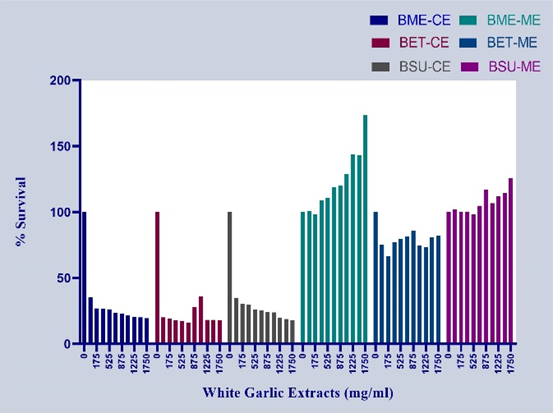
Figure 1. Cytotoxic Effects of White Garlic Extracts Obtained by Cold Extraction (CE) and Maceration (ME) Method on Caco-2 Cells at 24. Hours
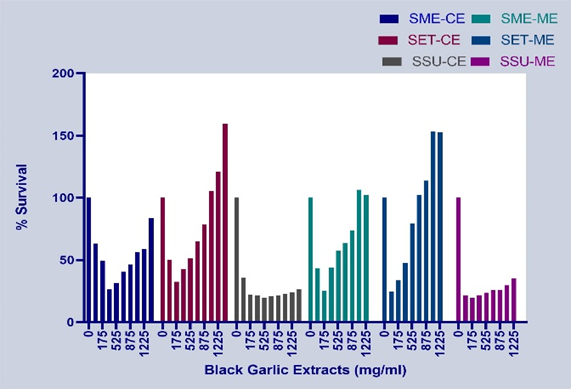
Figure 2. Cytotoxic Effects of Black Garlic Extracts Obtained by Cold Extraction (CE) and Maceration (ME) Method on Caco-2 Cells at 24. Hours
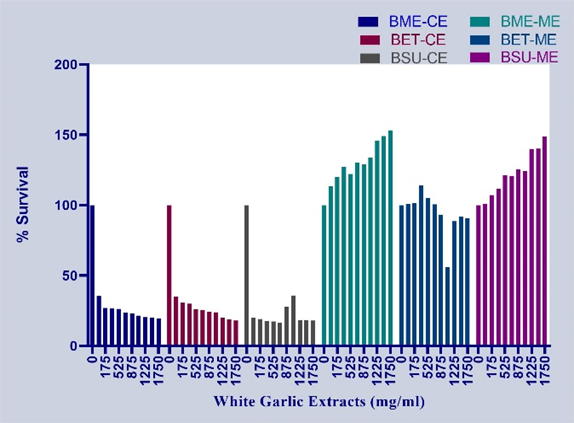
Figure 3. Cytotoxic Effects of White Garlic Extracts Obtained by Cold Extraction (CE) and Maceration (ME) Method on Caco-2 Cells at 48. Hours
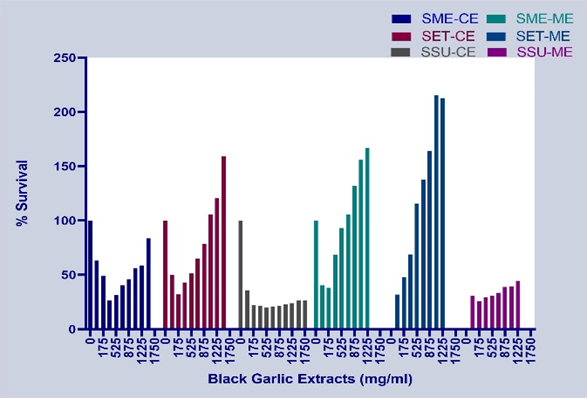
Figure 4. Cytotoxic Effects of Black Garlic Extracts Obtained by Cold Extraction (CE) and Maceration (ME) Method on Caco-2 Cells at 48. Hours
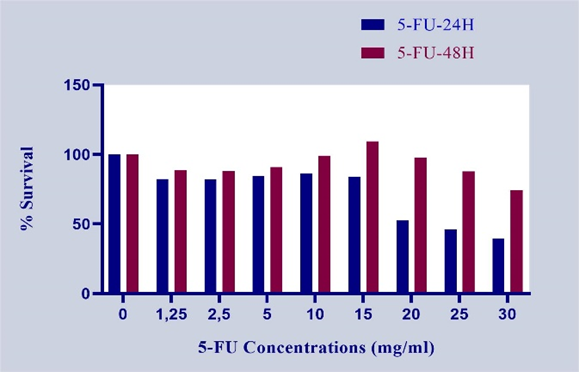
Figure 5. Cytotoxic Effects of 5-FU on Caco-2 Cells at 24. and 48. Hours
IC50 values of the MTT assay for 24-hour incubation in white garlic extracts obtained by cold extraction method were 62,50 mg/ml BME, 50.00 mg/ml BSU, 67.00 mg/ml BET, 175 mg/ml SME, 87.5 mg/ml SSU, 70 mg/ml SET while for 48-hour incubation were found IC50 value of BME 62.50 mg/ml, BSU 58.33 mg/ml, and BET 65.00 mg/ml. IC50 values of the MTT assay for 24 and 48-hour incubation in white garlic extracts obtained by maceration extraction method observed a proliferative effect. IC50 values of the MTT assay for 24 and 48-hour incubation in black garlic extracts obtained by cold extraction method were SME; 165,38 mg/ml, 305,25 mg/ml, SET; 63.00 mg/ml, 106,50 mg/l, SSU; 80.85 mg/ml, 80.85 mg/ml respectively. IC50 values of the MTT assay for 24 and 48-hour incubation in black garlic extracts obtained by maceration extraction method were SME; 66.85 mg/ml, 72,03 mg/ml, SET; 48.88 mg/ml, 59.60 mg/ml, SSU; 48.88 mg/ml, 56,60 mg/ml respectively. Although the maceration method reduced IC50 values compared to black garlic extracts, methanol and aqueous extracts of black garlic showed proliferative effects with increasing doses.
The research showed that black garlic has a significantly lower average moisture content than white garlic. This is because black garlic is produced through a fermentation process, where garlic is fermented at a specific humidity and within a 60-90°C temperature range for 60 days [43]. During fermentation, the moisture content in garlic is reduced due to microbial activity and chemical transformations, resulting in changes in water content. As a result, the production process of black garlic leads to a notable decrease in moisture content, which affects the density and creates a unique flavor profile in the final product.
In our data, white garlic is found to have a crude protein content of 11.16% ± 0.91, whereas black garlic has a lower level of 6.93% ± 0.03. These results suggest that during the fermentation of black garlic, there is a reduction in protein content, and the Maillard reaction may influence this process. The Maillard reaction is a complex chemical process that converts proteins into amino acids and affects the flavor and color of food. Zhang et al. [44] support the idea that such changes, particularly the lower protein content in black garlic, may be associated with the Maillard reaction, contributing to black garlic's unique flavor profile and compositional changes during fermentation. This aligns with the findings of Zhang et al. [45], which indicate a gradual decrease in amino acid nitrogen during thermal processing. Additionally, white garlic contains more crude fat (1.94%) than black garlic (0.71%), and white garlic also has a higher total ash content (2.51%) than black garlic (2.02%). These changes during thermal processing are also noted by Zhang et al. [45].
The total ash content indicates the mineral content and the decrease observed in black garlic could be due to thermal processing, as seen in similar studies. White garlic has a higher pH (6.93) than black garlic (4.67). The decrease in pH during thermal treatment, as observed by Shin et al. [46] and Bae et al. [47], is consistent with the formation of browning compounds. In the context of similar studies mentioned in your text, the work by Sajid et al. [48] and Otunola et al. [49] also supports the observed differences in moisture, crude protein, crude fat, and ash content between white and black garlic. Additionally, the pH decreases from 6.93 to 4.67, as Choi et al. [50] noted, which is consistent with this study's findings. The higher pH in white garlic might be attributed to the differences in the chemical composition affected by thermal processing.
Various techniques are used to extract primary and secondary metabolites from plants. The traditional method involves solid-liquid extraction, commonly known as maceration, where the plant is soaked in a solvent such as water, alcohol, or oil. Modern extraction methods, such as ultrasound, pressure, and microwave, have been developed to improve performance. These advanced techniques reduce process time, save energy, and minimize solvent usage. This enhances efficiency and can change extraction mechanisms, leading to different outcomes compared to simple maceration [51]. Maceration is a prolonged soaking of a sample in a solvent until its bioactive compounds dissolve [52].
The samples obtained through the maceration method generally exhibit higher total phenolic content than those obtained through cold extraction. Specifically, samples of SME and SSU have higher total phenolic content than BME and BSU. The maceration method typically provides higher total phenolic content due to prolonged contact with the solvent. This allows for more effective dissolution and extraction of phenolic components. Water-based extractions generally yield higher total phenolic content than methanol and ethanol extractions. This is particularly pronounced in the case of the SSU sample. SSU samples generally have higher total phenolic content than BSU samples, suggesting that the fermentation process of black garlic may enhance phenolic components. This difference indicates that phenolic components increase during fermentation, enriching plant constituents through chemical transformations. Additionally, water-based extractions generally yield higher total phenolic content than methanol and ethanol extractions. This may be attributed to water's more effective solubilization of specific phenolic components. White Garlic samples generally have lower total phenolic content than Black Garlic samples. The maceration method usually produces higher total phenolic content than the cold extraction method. This is believed to be associated with the maceration method involving longer contact with the solvent, allowing for more effective dissolution of phenolic components during this extended process. In the study, particularly in both extraction methods, SET has significantly lower total phenolic content than BET. White Garlic samples generally have lower total phenolic content than Black Garlic samples. In the maceration method, SME and SSU samples exhibit significantly higher total phenolic content than White Garlic samples. This difference suggests that the fermentation process of Black garlic may increase phenolic components. Previous studies on black garlic have reported that increased antioxidant capacity may be due to increased polyphenols and S-allyl-cysteine, a compound derived from alliin [53]. Temperature and cooking time increase the antioxidant activity of garlic by enhancing the extraction of bound phenolic compounds. This increases garlic's phytochemicals and antioxidant activity [54].
The methanol extraction of white garlic has shown a significant increase in total flavonoid content compared to the cold extraction method. This suggests that methanol extraction is more effective in extracting flavonoids from white garlic samples. The aqueous extract of black garlic has demonstrated a less pronounced increase than the cold extraction method. This implies that aqueous extraction may have a more limited impact on increasing the flavonoid content in black garlic. The ethanol extract of white garlic exhibited a total flavonoid content like the BME in the cold extraction method. However, extraction using the maceration method has shown an approximately four-fold increase in total flavonoid content. This indicates that ethanol extraction may be more effective in extracting flavonoids from white garlic. Additionally, in the case of black garlic samples subjected to heat treatment, no significant difference has been observed between the two extraction methods.
In the study, the decrease in DPPH activity in white garlic samples with the maceration method could be attributed to several reasons. The maceration method typically involves prolonged contact with the solvent. This extended extraction period might lead to the oxidation or degradation of certain components. Significantly, it can affect the stability of phenolic compounds, resulting in a decrease in DPPH activity. The solvent used in the maceration method may be less effective in extracting components that interact with DPPH radicals. Mainly, water-based solvents might reduce the solubility of phenolic components, contributing to a decrease in DPPH activity. Control of temperature may be more challenging in the maceration method. Elevated temperatures can reduce phenolic compounds' stability, which could mean that cold extraction is more effective at preserving phenolic components, thus maintaining DPPH activity. Different extraction methods can yield different phenolic profiles. The maceration method may be less efficient in extracting specific phenolic compounds, leading to a decrease in DPPH activity. Residues in the solvent used during maceration might react with DPPH radicals, diminishing their effectiveness. Combining these factors with the maceration method may reduce DPPH activity observed in white garlic samples. Changes in DPPH activity should be evaluated considering extraction conditions and the composition of the samples. BET exhibited higher DPPH• scavenging activity than SET (p>0.05), while the lowest activity was found in SET. A study found that the antioxidant activity increased for aqueous extracts as cooking temperatures increased. Conversely, the antioxidant activity decreased for ethanolic extracts as the temperature increased [54].
In 24 hours and 48 hours, the samples of BME, BET, and BSU, obtained through the cold extraction method, exhibit a more effective cytotoxic effect on Caco-2 cancer cells. In contrast, the samples obtained through the maceration method are observed to enhance cell viability. Cold extraction and maceration methods can influence the profiles of bioactive compounds transferring from plant material to the solvent. The more efficient extraction of specific bioactive compounds by cold extraction may lead to a cytotoxic effect on cancer cells. Additionally, varying agitation durations can potentially increase the risk of microbiological contamination. Moreover, different agitation periods are thought to elevate the risk of potential microbiological contamination.
The positive effects of samples obtained through the cold extraction method of SME on cell viability are believed to arise through various mechanisms. The first reason for these effects is that bioactive compounds in black garlic, such as sulfur components, support cell viability by regulating intracellular functions and increasing cell membrane stability. Secondly, the potent antioxidant properties of garlic protect cells from oxidative stress, allowing them to remain healthy and thereby enhancing cell viability. Thirdly, the immunomodulatory effects of black garlic can increase cell viability by optimizing immune responses and strengthening defense mechanisms. Additionally, promoting cell division (proliferation) by black garlic may have contributed to the increased cell viability at 24 hours with dose escalation, reaching over 100% viability at 48 hours. Lastly, the time-dependent increase in proliferative activity indicates that the effects of black garlic on cells intensify over time, becoming more pronounced in the long term. SME obtained through maceration has exhibited a higher proliferative effect at lower doses at 48 hours compared to 24 hours in Caco-2 cells.
Additionally, the impact of maceration-derived SME on cell viability at 24 hours is similar to the effect shown by SME obtained through cold extraction at 48 hours. The extended duration of maceration may facilitate greater penetration of the extract's components into the cells, potentially leading to a more pronounced increase in cell viability. This circumstance could result in a more effective release of beneficial compounds, positively influencing cell viability. However, prolonged maceration might increase the risk of microbial contamination, which can affect the overall quality of the extract and its impact on cell viability.
Overall, the analysis of different extraction methods reveals that cold extraction generally provides better results regarding bioactive compounds' efficacy, including higher antioxidant activity and better cytotoxic effects. However, the choice of extraction method should be carefully considered, considering factors such as time, solvent, and potential contamination risks.
The lower moisture content in black garlic highlights its sensitivity to specific humidity and temperature conditions during fermentation. Concurrently, reductions in protein content and alterations in other nutritional components are attributed to the Maillard reaction's influence. Comparative analysis of extraction methods demonstrates that maceration yields higher total phenol content compared to cold extraction. This finding suggests potential phenolic enrichment during fermentation, as evidenced in SME and SSU samples. The observed cytotoxic and proliferative effects in Caco-2 cells underscore the significance of bioactive compounds and extraction techniques in modulating cell viability. The study emphasizes the necessity for a thorough understanding to optimize garlic fermentation and extraction processes, potentially enhancing the production of bioactive compounds with health benefits. Moreover, while high antioxidant products may aid in cancer defense, their consumption warrants caution among cancer patients.
T.S. and D.O.U. performed the experiments and analyzed their data. All the authors wrote the manuscript, prepared figures, and reviewed the final manuscript.
The study was conducted at Ankara University, Faculty of Veterinary Medicine, Department of Biochemistry, Molecular Biology (RIA Laboratory), and Central Research Institute of Field Crops (Nutrition and Health Laboratory of Quality and Technology Department). This research received funding from the Directorate of Scientific Research Projects at Ankara University for the “Postgraduate Thesis Project (Doctorate),” with project number 21L0239022.
Supporting Information is available from the Wiley Online Library or the author.
The authors declare no conflict of interest.